-
Posts
8,925 -
Joined
-
Last visited
Content Type
Profiles
Forums
Developer Articles
KSP2 Release Notes
Bug Reports
Posts posted by sevenperforce
-
-
4 hours ago, JoeSchmuckatelli said:7 hours ago, sevenperforce said:
using a small ullage burn to nudge the props from one tank to the other
Wait, what?
I've not been following along... The plan is to use inertia to shift the fuel?
Isn't slosh a problem?
Well that kind of gets at the root of the issue: there is no straightforward way to transfer propellants in microgravity.
Think about it. You've got two tanks, and you've got them connected somehow, and you've got a mix of gases and liquid in one tank but only gas in the other tank, and you need to transfer the liquid. How do you do it without using gravity?

Even if you have a way to increase the pressure in one tank and decrease the pressure in the other tank, you're just going to be pushing gas, because gas pressure waves move at the speed of sound while liquids move...well, slowly. Pumps won't work unless you can get the liquids into the inlets to begin with.
Prior mechanisms to transfer propellant have been extremely volume- and mass-limited and have typically used stable hypergolics. Russian vehicle prop transfers typically use a feeder tank in a disposable refueling vehicle, where the propellant is held inside a bladder that can be compressed by gas pressure to physically push the propellant into the destination tank:
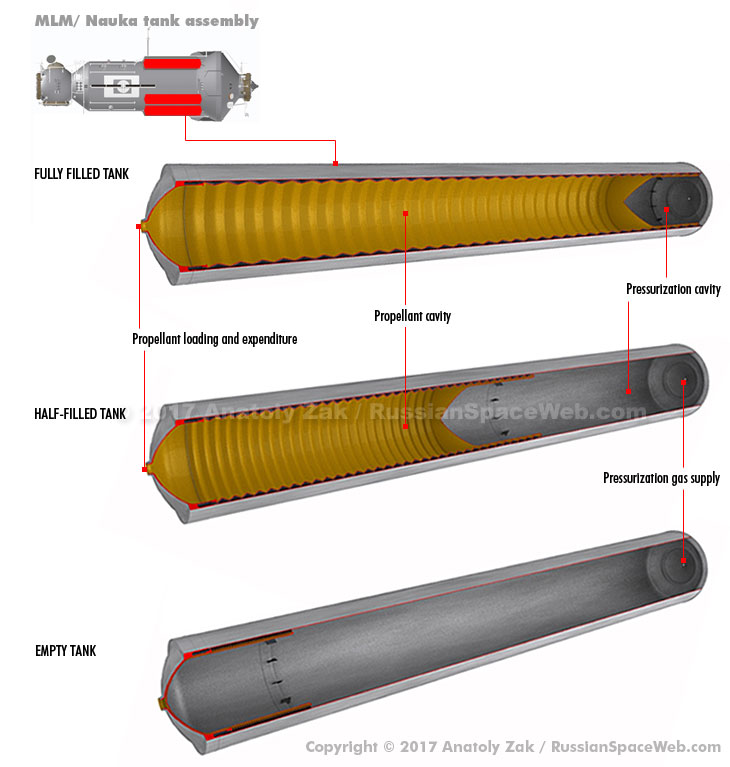
But that's a small-scale solution. You can't very well fit every Starship tanker with inflatable bladders holding all of their propellant -- it would be so heavy that the damn thing would never get to orbit.
Propellant settling is one big problem here. That's been tackled in a number of ways; most upper stages use solid ullage motors or cold-gas thrusters for settling, while the Space Shuttle and most capsules used a complex engine feed inlet with a structure that holds fluid inside it by surface tension. Once settled, the subsequent propellant burn provides the acceleration needed to keep the propellant flowing into the inlets. Starship currently uses propulsive vents (basically cold-gas thrusters) for settling before restart, although it may switch to hot-gas thrusters eventually. So if they provide settling with gas thrusters, they'll create an impulse that will get the propellant flowing (or, technically, an impulse that will move the tanks in one direction while the propellant is stationary relative to the original trajectory).
At that point they could try to use some sort of pump, but it's a more mass-efficient solution to just keep the gas thrusters thrusting and let the propellant drain "down" relative to the thrust vector, just as it would under the influence of gravity. In particular, the flow from the donor tank in to the recipient tank is going to lower the pressure in the donor tank and increase the pressure in the recipient tank, so the pressure increase in the recipient tank can be used to continuously feed gas thrusters on that tank, keeping the whole stack settled:

Of course you'd need COPVs or maybe a resistance heater in the donor tank to keep it at equal or higher pressure than the recipient tank, but that's really no big deal.
-
4 hours ago, DAL59 said:
Would it be technically feasible to make a Falcon-Heavy derived HLS? One launch to send a small lander to LEO, a second launch to send a kicker stage to LEO to dock with the lander and take it to NRHO, no superheavy launch vehicles or orbital refueling required.
This was the original plan for HLS as an accompaniment to SLS, but then Starship came along and obviated that.
-
4 hours ago, CatastrophicFailure said:5 hours ago, CBase said:
Just curious, but how do you demostrate propellant transfer with a single vehicle ? Any idea what we could observe during IFT-3 ?
From what I’ve gleaned it’s just a transfer between main and header tanks. Little to no change to vehicle, plumbing’s already there (to fill header in the first place), zero additional risk to mission.
I believe I had read that they would have a separate actual tank in the payload bay and would test transfer between it and the vehicle tank, rather than transfer in and out of headers. The connections would already be in place and it would simply be a matter of opening the valves and using a small ullage burn to nudge the props from one tank to the other.
-
On 12/5/2023 at 4:35 PM, Exoscientist said:On 12/5/2023 at 4:16 PM, Geonovast said:On 12/5/2023 at 4:11 PM, Exoscientist said:
SpaceX still has not demonstrated the Raptor can be restarted in flight
What did SN8, SN9, SN10, SN11, and SN15 use for their landing attempts, then?
If you review the Starship landing tests, it has happened multiple times a Raptor engine has leaked fuel and caught fire. This was only with one or at most 3 engines. Imagine this with 33 engines.
I’m positing the Raptor is no more reliable now than on those landing tests on relights.
You said "restarted in flight". The high-altitude hop tests demonstrated in-flight restarts.
You may certainly opine that SpaceX cannot reliably restart the Raptor in flight (although all of those were Raptor 1 and there have been no demonstrated refiring/restart issues with Raptor 2), but you cannot deny that those Raptors did in fact restart in flight. And you still have no evidence beyond speculation that Raptor 2 has any startup issues at all, given that (a) the lack of completed Superheavy startups for OFT-1 was likely associated with sensor excursions and no actual engine failures, (b) the subsequent shutoffs on OFT-1 were associated with leaks from a hydraulic TVC system that no longer exists, and (c) IFT-2 had no difficulty keeping all 33 engines firing from ground to staging.
I don't know why you're on about the engines. Engines are an area where SpaceX seems to have the most success. There are more issues with propellant slosh, maneuvers, the survivability of tile failures on re-entry, and so forth.
-
18 minutes ago, Exoscientist said:
Note, I increased the vacuum ISP to 482.5s A remarkable report suggested a hydrolox upper stage could get a 482.5 s vacuum ISP with a quite high expansion ratio of ~625.
This approach makes no sense. If you think that you can simply arbitrarily increase the specific impulse of any hydrolox engine, then why do it with the J-2X but not with the RL-10s? Also, your numbers were wrong to begin with: the RL10C-3 for the EUS develops 460.1 seconds Isp, not the 448 seconds you gave it.
In reality, you've got it upside down. That particular report is featuring an expander cycle engine, which has an intrinsically high specific impulse because it doesn't burn any of the propellant to run the pumps. The J-2X, like the J-2 before it, is a gas generator engine which (as I've told you before) cannot achieve anything near the maximum attainable specific impulse of an expander cycle.
Comparing the J-2X to the J-2 will illustrate that pretty cleanly. The J-2X has 3.35x the expansion ratio of the J-2 and 1.57x the chamber pressure of the J-2, but only increased the vacuum specific impulse by a paltry 6.4%. Specific impulse is roughly proportional to the square root of (1 - RP0.26), where RP is the pressure ratio between the exit and the chamber, so if you increase the expansion ratio by from 27.5:1 to 92:1, you're going to get a MAXIMUM of 9.4% increase in vacuum specific impulse...obviously the actual number is slightly lower due to built-in inefficiencies and other factors. If you use a massively oversized nozzle to go ahead and increase the expansion ratio from 92:1 to 625:1, you're going to get a probable increase of ~5.8% which is going to get you no higher than 474 seconds.
And that would be for a nozzle diameter 2.61 times greater than the already massive 3-meter nozzle of the J-2X: nearly 8 meters. Adding a nozzle extension onto the J-2 to create the J-2X already increased its mass by 680 kg (actually more, because the other J-2X upgrades decreased the mass of the powerplant and chamber). Approximating the J-2X nozzle extension as a truncated cone with a lower diameter of 3 meters, a height of 1.3 meters, and an upper diameter of 2.1 meters, we get a lateral surface area of 11.02 square meters. Adding an additional nozzle extension to increase the exit diameter to 7.83 meters would require the new extension to be 6.98 meters in length and have a lateral surface area of 125.65 square meters, adding something like 7.98 tonnes.
Which brings us to additional problems. All four RL10C-3 engines together have a mass of 920 kg and occupy 2.17 meters of vertical space with the nozzle extension stowed. The J-2X has a mass of 2.47 tonnes and a fixed length of 4.7 meters, while your super-nozzle-extension J-2 (I'll call it the J-2Z) would have a minimum stowed length of 5.84 meters. So you'd need to remove 3.67 meters of length from the EUS, reducing its propellant capacity by something like 24%. Remember that you can't just make the EUS longer because this single-launch architecture of yours ALREADY doesn't have enough vertical space to fit both a capsule and a sortie lander. Your math didn't account for increased mass OR increased length.
Finally, there were other errors in what you plugged into Silverbird. For example, the dry mass of an SLS booster is 102 tonnes, not 110 tonnes. The dry mass of the SLS core is 85.3 tonnes but you have to add 7.4 tonnes for the interstage (Block 1's LVSA interstage massed 4.5 tonnes with a lateral surface area of 177 square meters so scale up for Block 1B's longer interstage with its cylindrical surface area of 292 square meters). Similar errors have been corrected throughout.
Here are the correct calculations (spoilered for length). First, we create a baseline using the Silverbird calculator with the existing SLS Block 1B to gauge overestimation:
Spoiler
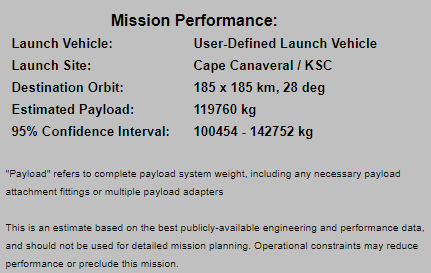
It gives just under 120 tonnes, which is significantly more than the 105-110 tonnes claimed by NASA. As I've explained before, Silverbird tends to overestimate both T/W ratio and sea level specific impulse when dealing with altitude-compensating sustainer engines like the RS-25. So we know we need to reduce whatever Silverbird tells us by ~11.4%.
Next, let's use the J-2X. Note that I have added the increased mass of the bigger engine but also reduced the length, propellant capacity, and dry mass of the EUS to accommodate the greater length of the engine.
SpoilerThe J-2X is 2.53 meters longer than the stowed RL10C-3s, so I added 2.53 meters to the length of the interstage and thus 1.67 tonnes to the weight of the core. The tank length of the EUS is 15.39 meters so we reduce its propellant capacity by approximately 16.4%. The tank mass of the EUS (without engines) is 13,190 kg, so we reduce this by 16.4% as well and then add in the 2.47 tonnes of the J-2X.
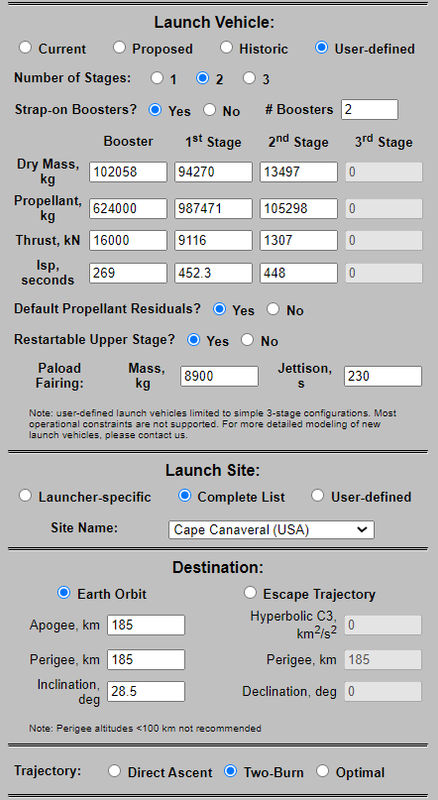
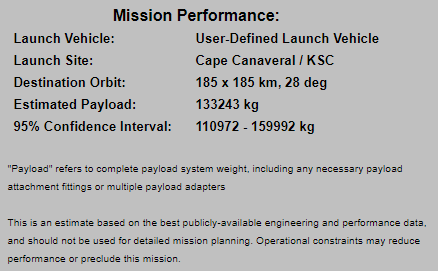
With the overestimation reduction, that's 119.6 tonnes to LEO: certainly an improvement, but not enough to get us the kind of performance we'd need for a single-launch architecture. And now finally let's use your imagined J-2Z, adding 7.98 tonnes for the nozzle extension and reducing the length and propellant capacity of the EUS accordingly:
SpoilerThe J-2Z is 3.67 meters longer than the stowed RL10C-3s, so we add 2.42 tonnes to the original mass of the core stage. We must now reduce the length of the original EUS to 76.2%, giving it a tank dry mass of 10.05 tonnes and a prop load of 96 tonnes. Finally we add the total 10.45 tonnes of J-2Z to get the true dry mass of the shrunken EUS. We do get a slight bump up of vacuum thrust from the longer nozzle.
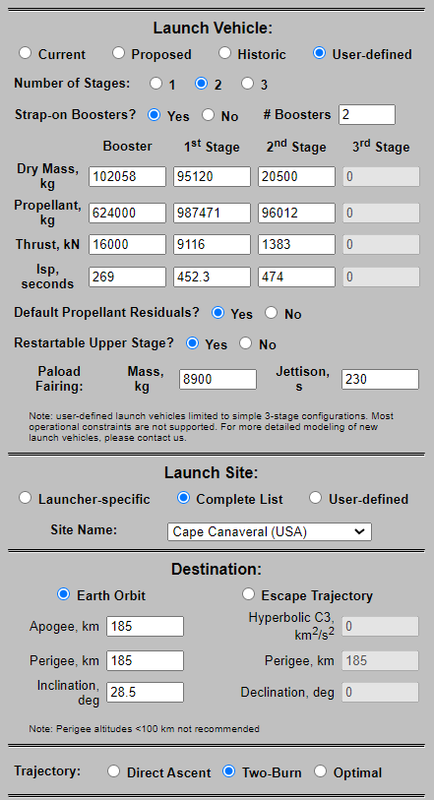
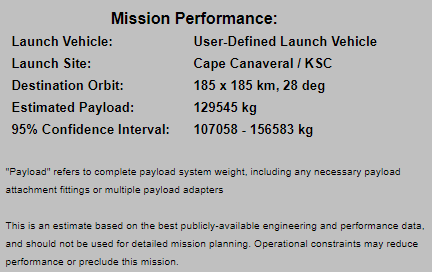
And applying the same reduction, that gives us 116.3 tonnes to LEO. So this super-high-expansion-ratio idea is sending us in the wrong direction. That makes intuitive sense, after all: if it made sense to get higher specific impulse by attaching a bigger nozzle extension, that's what rocket engineers would do! But it doesn't, because nozzle extensions are really quite heavy, so there's always a balancing test.
3 hours ago, Exoscientist said:In the next post, what’s really important is the payload to TLI. I’ll calculate that next.
You need around 3.15 km/s for TLI. Assuming a 185x185 km parking orbit, your parking orbit velocity is 7.793 km/s from the vis-a-vis equation. Adding 3.1 km/s at perigee raises your "apogee" to 451,517 km (which makes sense given that the moon is a little under 400,000 km away and you need to swing past it for an efficient lunar orbit insertion).
So if you plug my baseline SLS figures above into Silverbird just as I did before but setting a desired apogee of 451,000 km, you get an estimated TLI payload of 46.7 tonnes, 11.2% more than the 42 tonnes that NASA claims can be sent to TLI by SLS Block 1B Cargo. (Note: this should give us some confidence in our method because the overestimate remains consistent.) Using the J-2X figures from above, we get a TLI payload of 48 tonnes, which comes to 43.2 tonnes when you apply the overestimate. So it's really not a significant increase once you are looking at TLI deliveries. Could it do an Apollo-style mission? Sure: if you gave it the exact same capsule, service module, and lunar module of Apollo. But so could ordinary SLS Block 1B.
-
41 minutes ago, Spaceception said:
Oh, I meant something directly applicable to Artemis. Starship working (e.g. RVacs working) is more of a given for general operations.
Yeah, but also firing an RVac on a modern launch vehicle was definitely something. I don't believe we've clustered more than two engines of any appreciable size on an upper stage since the Saturn V, and the whole concept of a fixed-mount (that is, non-gimbaling) vacuum engine on an upper stage with separate full-size engines providing attitude control is pretty unique. We also haven't used vacuum-expanded regeneratively-cooled-nozzle engines in a vacuum...like, ever.
-
10 hours ago, SunlitZelkova said:
I'm amazed at how you and others can whip out these great graphics so quickly. I always wondered what a Starship launched Orion architecture might look like but didn't realize it could carry such a large lander. I always envisioned it as a sort of "Commercial Heavy Crew Program".
Part of me really likes such a concept because I think Orion looks cool and think it's a decent way to allow some degree of pork while otherwise trying to use better priced stuff as much as possible, but at the end of the day all of this is really obviated by an EOR architecture with Crew Dragon taking crew to meet Starship HLS in LEO.
Obviated to some degree, yes, but if we are going to contemplate any expendability to Starship+Superheavy then we should just go with an all-up expendable architecture like the Saturn V.
-
14 hours ago, tater said:
Starship, assuming a 75t variant (which is actually pretty beefy, could be lower), could send the 60t lander to NRHO (I'm having it fly all the way to Gateway here, else lander needs more dv) with 225t of residual props. That's 285t of payload, including lander. In short, and expended SS could send a 10t dry hypergolic lander to Gateway. Note I assumed a single stage lander.
Elon had previously said that Raptor V3 would bump a "better optimized" Starship V1's expendable payload up to 300 tonnes LEO. I'm assuming he's accounting for a vehicle that is specifically being launched without heat shielding and so forth. A while back he had suggested 40 tonnes dry for a minimal-mass expendable BLEO Starship without SL Raptors, so if we keep all six Raptors then we're looking at something like 45 tonnes dry. We also know that the main tanks on Starship V1 carry 1170 tonnes of propellant. Plugging these values into the rocket equation (with an average ~371.75 seconds Isp, assuming an even split between SL and Vac Raptors for the first two-thirds of the burn and only one SL Raptor accompanying the Vacs for the last third of the burn) gives us 5,396 m/s of Δv from staging off an expendable Superheavy to get to LEO.
But Starship V2 has an expected tank stretch and bump up to nine engines. The main tanks of Starship are about 23 meters in (vertical) length, so we could expect a notional 7-meter tank stretch to add around 350 tonnes of propellant. Crudely subtracting off 9.6 tonnes for engines from the 45-tonne Starship V1 got us tankage and plumbing mass of ~35 tonnes, so let's bump this up to 42 tonnes to account for the stretch, then add in nine engines to get to around 57 tonnes dry. Staging velocity will be just slightly lower here due to the increased mass for Superheavy to lift, so let's subtract 100 m/s from staging velocity (increasing the corresponding Δv requirement to 5,496 km/s). We bump up the average specific impulse to 374.9 seconds, though (assuming all nine engines firing for the first third of the burn and only one SL raptor accompanying the Vacs for the last two-thirds of the burn). Load that up with payload, and you find that the expendable Starship V2 can presumably put 383 tonnes into LEO.
If it can put 376 tonnes into LEO, then it can send ~101 tonnes to TLI monolithic. But we can do better.
Let us imagine a "Starship Saturn" with two expendable upper stages that together have the same total expected propellant capacity of Starship V2. All nine engines on the second stage and two Raptor Vacuums on the third stage:
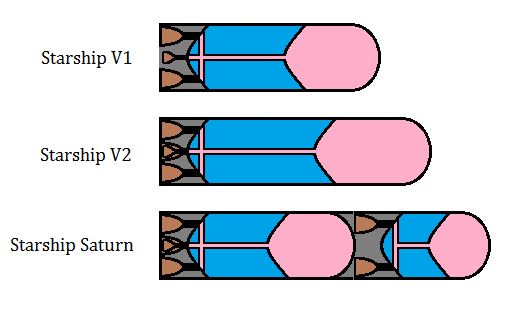
Doing it this way allows us to stay within known variables for the stack (since we are only increasing propellant and tank weight by what is already expected for Starship V2), so this shouldn't require any significant changes to Superheavy. It gets taller, of course, but only by the height of the new second interstage.
With these constraints, figuring out where to "divide" Starship V2 into two separate stages becomes a simple optimization problem. Maximum payload is reached by placing 461.5 tonnes of propellant onto the third stage, which allows us to send just over 132 tonnes to TLI, and the third stage has a staging T/W ratio of 0.98:1, which is fine since it will be mostly firing in orbit. It will stage just shy of LEO and burn for 101 seconds to circularize, and you'll only need a 126-second burn for TLI.
You'll notice that the propellant mass on this third stage is only a bit more than the total amount of propellant that gets added from the tank stretch, so it may be much easier (for this purpose) to just keep the original Starship V1 tank tooling but strengthen and plumb the bottom for nine Raptors instead of six. Won't reduce your TLI delivery by much.
Another possibility, depending on what your lunar stack design is like, is to use the terminal stage as the braking stage to get into cislunar orbit. Things get a little trickier here because we assume some boiloff will occur in transit. Let's assume a four-day coast and 0.1% boiloff per day, measured against total original propellant mass on the third stage. Now the total required Δv is much higher, which changes up how you balance the stages: here the optimal propellant load on the third stage is 368 tonnes, and the sorties stack that is delivered all the way to low lunar orbit is a whopping 95.5 tonnes. If you want to squeeze out just a little more from the whole affair, you can even drop down to a single vacuum Raptor, although that will double the length of your burns which could cause either Oberth or cosine losses depending on the trajectory optimization you use.
If you can deliver 95.5 tonnes all the way to low lunar orbit in a single launch, then you can deliver Orion AND a 69-tonne lander. That's enough mass budget for pretty much any approach you want to use.
-
On 12/3/2023 at 8:44 AM, darthgently said:
It would be interesting to have a fuel barge near the landing barge, put in just enough fuel into the landed booster to hop it back to Canaveral. Super fast turnaround, bay-bee.
Hmm.
Sea level thrust of a single Merlin 1D is 845 kN, and only one row of three engines is restartable. Max thrust for liftoff is therefore 2.54 MN. They could add more TEA-TEB to accomplish more restarts, at a minor weight penalty. Assuming the need for a T/W ratio of at least 1.3, the landed stage could have a liftoff mass no greater than 199 tonnes. Assuming 24 tonnes for an empty booster, that allows 175 tonnes of propellant. However, thrust will be lower since the fuel barge won't be able to effectively subcool the propellants, so let's say it gets 150 tonnes. That's a total Δv of 5.48 km/s, so definitely doable.
What would be more difficult would be strengthening the legs to increase their load-bearing capability by a factor of more than seven and redesigning them so they can fold back up on their own at liftoff.
Kinda pointless when you have to send the landing ship out and bring it back between launches anyway.
-
7 hours ago, tater said:
Yeah, there were some explosions at the rear. Still, detonation looks at the common dome. Could be a RUD started, FTS then goes off as well. Still, it's probably as Manley suggests. It will be interesting if they can fix it with timing changes on the boostback.
Cascading engine failure due to fuel starvation followed by commanded AFTS.
-
8 minutes ago, sevenperforce said:
What if you placed your infrastructure in an eccentric orbit with a periapsis on the daylit side (with some sort of approach that uses precession to keep it there) in order to maximize the amount of time spent in Earth's shadow? Would those "free" heating and cooling cycles be useful for anything?
35 minutes ago, tater said:double-sided PVs that also have transmission in the layers (phased array) to function as orbital PV supply
The phased arrays on Starlink satellites can target 12" x 19" receiving dishes (although obviously the signal is significantly overlapping the receiver). I wonder if it would someday be possible to safely beam power to moving vehicles on the ground.
It just occurred to me that if you can place a satellite in a Molniya-style orbit to keep it in the sun's shadow as much as possible, you can also place it in an opposite orbit that keeps it in sunlight as much as possible. If they were able to solve linear losses in phased-array beaming (or at least partially solve them) then the extra distance wouldn't be a problem.
I'm reminded of the deep space telescopes that use lasers to create a guide star to adjust for atmospheric diffraction:
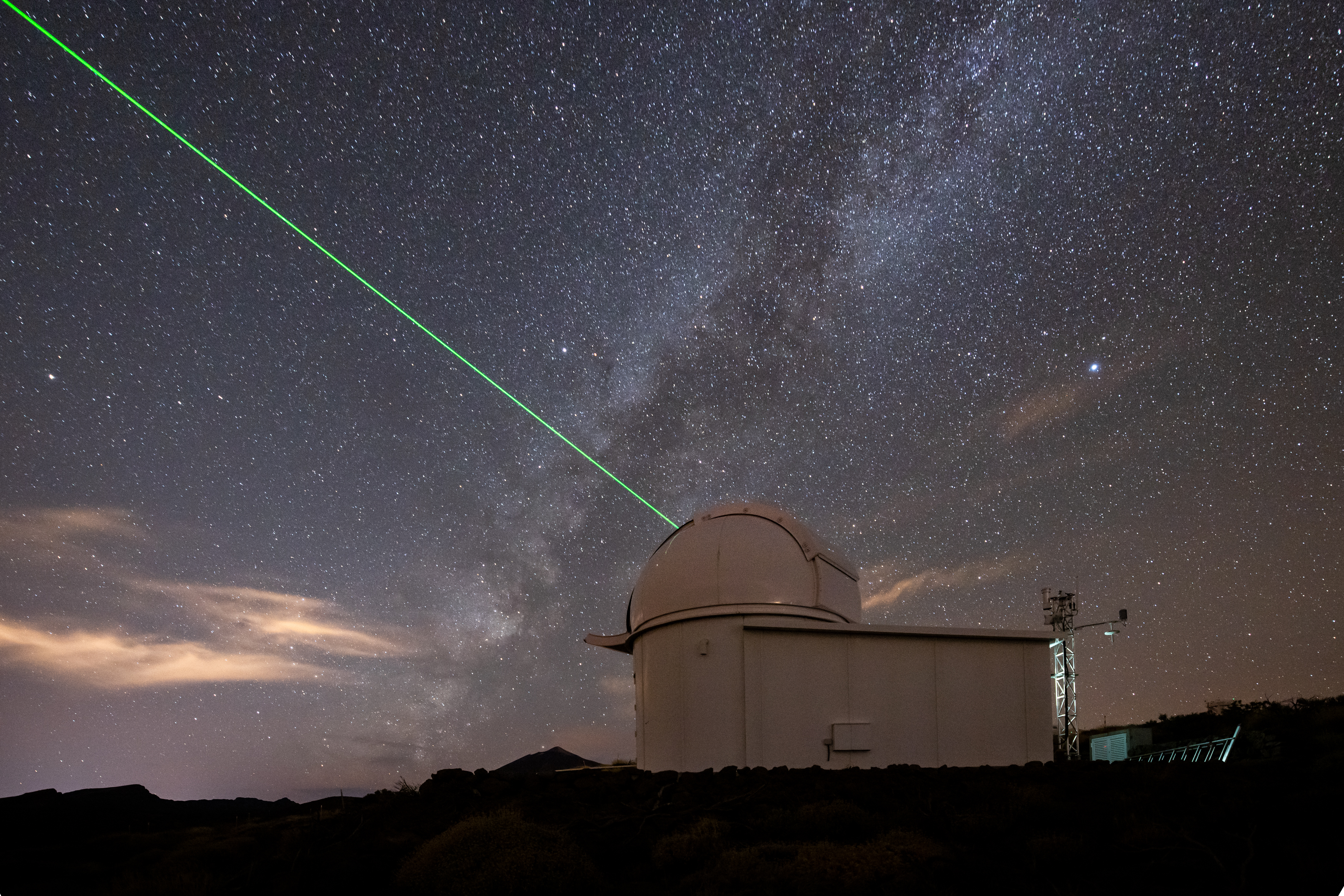
What if the phased array power transmitter and the corresponding receiver could communicate information about the shape of the power beam in order to use the phased array to adjust for atmospheric diffraction and reduce transmission losses?
-
A killer app for maximizing the utility of low-cost heavy-lift launch services can come in three flavors:
- Do it better. There are things that we do on Earth, like silicon wafer manufacturing and power generation, that are constrained by being on Earth's surface (e.g. by gravity or by lack of access to peak solar wattage) and thus could potentially be done better in space.
- Do it more. There are commodities here on Earth that don't have a large market because they simply cannot be produced at scale. An example that definitely wouldn't lend itself well to going to space is seafood farming: the price of crab (and a number of other seafood products) is high because crab can't really farmed and has to be fished. There may be commodities on Earth that have high value regardless of supply and that we've never thought of producing in space, but we could.
- Do it first. The killer app may be something we've never thought of before. Not too long ago, the concept of streaming services was simply unimaginable. Nobody was coming up with the idea of offering streaming video on demand because the infrastructure didn't exist.
We kind of need to be looking in different places here on Earth to fit these three different niches.
I wonder what thought has been given to using specific orbits for specific purposes. Many of the concepts for space-based infrastructure focuses on what to do in an essentially frozen orbit, but orbits don't have to be frozen. What if you placed your infrastructure in an eccentric orbit with a periapsis on the daylit side (with some sort of approach that uses precession to keep it there) in order to maximize the amount of time spent in Earth's shadow? Would those "free" heating and cooling cycles be useful for anything?
26 minutes ago, tater said:His case closed for high-cost power delivery to certain places like remote military bases in the arctic with 100% of the launches sourced with Atlas Vs at 2-3X the cost of a retail F9 launch.
The phased arrays on Starlink satellites can target 12" x 19" receiving dishes (although obviously the signal is significantly overlapping the receiver). I wonder if it would someday be possible to safely beam power to moving vehicles on the ground. Even if you coated every inch of a Tesla with solar cells, it wouldn't pick up enough power to recharge as it drives. But if you had a large space-based power generation array that was collecting many thousands of square meters of sunlight and beaming it directly to individual vehicles, that might work.
The United States sorely lacks interstate mass transit infrastructure, and bus tickets are terribly expensive in part due to the cost of fuel. If you could beam power directly to the roof of an electric bus so that it would never need to stop and recharge batteries, you could slash transit costs.
26 minutes ago, Exoscientist said:Raptors have leaked fuel and caught fire multiple times during relights in the Starship tests
This was literally a completely different Raptor iteration.
-
5 hours ago, tater said:
No evidence of that at all. FTS is automated, and based on the flight path of the vehicle. Unless they say the FTS was triggered, I'm gonna assume a leak resulting in it blowing itself up.
I would push back on this. If there was a flow failure or attitude deviation or some other anomaly shortly before SECO, that could easily result in flight path deviation and would trigger AFTS.
If there was an overall thrust shortfall then it could have same same effect as OFT-1 on the booster, where it kept doing its best but ended up out of flight path right at the end of the burn. Is there any indication that the burn was taking longer than planned, or that the ship was moving slower than it should have been at that time?
4 hours ago, Exoscientist said:The accelerated LOX flow rate may have been due to leak in one of the engines, in which case it would be another instance of the Raptor leaking fuel.
LOX leaks in an engine pretty rapidly lead to engine-rich combustion. Doubt that’s the case.
Damage to the LOX tank, perhaps from spalling during hot staging, could be a more likely root cause. It wouldn’t even need it to be a leak alone; if you have a small leak, then you will have autogenous pressurization issues and end up consuming more LOX that way too.
4 hours ago, darthgently said:If think that far more research had been done on rocket engines pushing the rocket they were attached to than engines pushing craft in the plume. The hot stage ring ass'y would catch a lot of force
Yep. Hydraulic shock (the “water hammer” effect) can be difficult to model, especially when there is almost no way of accurately predicting the retrograde acceleration induced on the booster from Starship’s six engines, let alone the actual gradient and rate of change of that acceleration during the hot staging event.
9 minutes ago, Mikki said:Exact, the needed pumps could run during the flip maneuver with zero gyro forces when mounted horizontally and inline with the flip axis...
I am searching for Raptor 2 pump cut images or the specific engine details but this seems hopeless on the internet (for reasons
 ), so i estimate the both shafts at around 80 and 60 kg... rpm is unknown during flip as is the shape... Only the weight of the whole motor is known to be around 1`600kg (sealevevel). The torque is insane btw, i don`t want to upset anyone here because basically no-one can imagine it.
), so i estimate the both shafts at around 80 and 60 kg... rpm is unknown during flip as is the shape... Only the weight of the whole motor is known to be around 1`600kg (sealevevel). The torque is insane btw, i don`t want to upset anyone here because basically no-one can imagine it.
I don’t see that ever being possible. Raptor has two turbopumps, one directly in line with the engine thrust factor and one slightly offset. The turbopumps are slightly different sizes as well. Even if you could do a complete redesign and rotate the pumps by 90°, they likely still wouldn’t be on parallel axes, making any flip alignment impossible. Even if you manage to line up the pumps on the same axis, you would have to rotate all of the raptor engines onto the same alignment to make that work, which is a complete plumbing redesign as well.
-
35 minutes ago, darthgently said:
Interesting thread
Ooooooh.
It would seem, perhaps, that six Raptors blasting Superheavy at close range produce more “negative thrust” than the prograde thrust of three Raptors running at the other end. To the point that the propellant would continue forward while Superheavy started to slow.
-
8 minutes ago, Exoscientist said:
This observer noted the booster reached far lower speed than expected:
https://twitter.com/phrankensteyn/status/1726033391605211547?s=61
To get all engines to fire without leaking or otherwise failing I was wondering if they were fired at partial thrust.
In the video @tater attached above, the Starship+Superheavy stack clears its own height in under eight seconds. Very sporty coming off the pad. I don't see any indication that the engines were being downthrottled.
Remember that the engine bay leaks in OFT-1 were associated primarily with hydraulic fluid. Full replacement with ETVC means no hydraulic fluid to leak this time.
I'm not sure where that particular dude on Twitter is getting the notion that the booster should have dumped 3.2 km/s at staging. A nominal Falcon 9 mission with boostback, like Crew-7, stages at 1.72 km/s airspeed; that's only slightly higher than Starship+Superheavy which is itself a completely different vehicle with a different launch profile and different boostback characteristics (not to mention that this was a test).
-
22 minutes ago, RCgothic said:
And even if it did achieve passive heat-shield-first stability, that wouldn't last for long because aero forces would shred the open base of the fairing.
Most likely not, but I (personally) wouldn't be too dogmatic. When Skylab fell on Australia, surviving fragments included a 1600-lb fuel tank bulkhead from the attached stage as well as a 5100-lb airlock shroud 22 feet in length. These early Starships are relatively over-engineered so the steel fairing rings could conceivably be strong enough to handle the base drag.
Of course nothing would survive hitting the water at half the speed of sound.
-
12 minutes ago, Exoscientist said:
Could the payload bay have survived reentry? The canards at top could help with streamlining during retry.
For the Starship, the payload bay is different than just the fairing of a normal rocket. The rings and the nose cone are welded together steel, rather than only a fairing designed to separate apart when jettisoned.
It definitely has a heat shield, but the question is whether the intact section would have had passive aerodynamic stability. I think the answer is almost certainly no. Starship achieves shield-first aerodynamic stability during re-entry using active control of all four drag flaps, but without only two flaps and no active control I don't see how any orientation provides passive stability. The center of mass and the center of drag will be very close to each other which would likely induce either a tumble or a flat spin, either of which would result in the vehicle being ripped apart by aerodynamic forces.
(This was the same fate for both Challenger and Columbia. Although Challenger is often said to have "exploded" and Columbia is said to have "burned up", both orbiters were ultimately destroyed by aerodynamic forces while tumbling: Challenger when the loss of active engine control could no longer keep the stack oriented and Columbia when differential drag on the half-melted wing caused roll and yaw deviations too great for the control surfaces to counteract.)
It is very unlikely that the intact-but-tumbling payload bay of Starship would achieve ANY passively-stable orientation, let alone one in which the heat shield was properly pointed into the airstream.
-
22 hours ago, Exoscientist said:On 11/19/2023 at 8:19 AM, darthgently said:
the vacuum engines were burning continuously from stage separation on, so not sure about your conclusion.
On the 1st test flight some booster engines worked fine at launch, but failed later on in the flight. The same could have happened with the vacuum Raptors, in regards to failing later in the flight. I have no information to confirm that, though. Whenever a rocket stage fails, the engines are the first thing focused on. Since the sea level engines worked fine, that leaves the vacuum engines to be scrutinized.
On the first flight, hydraulic fluid leaks in the engine bay led to fires which caused a rapid cascade of knock-on failures of other engines. There's no indication of any engine bay fires in the second stage, and any such failures (if they were similar to the ones in the first flight) would have taken place earlier in the six-minute burn.
18 hours ago, Deddly said:On 11/19/2023 at 8:55 AM, Mikki said:I just re-read Alemberts gyroscopic theory and it states that fast rotating bodys exert unusual very high counterforce (torque) tangential to a second applied rotation (force vector), which are unpredictable and surely very uneven on complex shapes like pumprotors.
You can calculate this force on a fast rotating straight rod, but a pumpshaft with curved blades and impellers is just structural chaos.
Don't/can't they have booster rotation on the same axis as the pump rotors?
They don't; Raptor 2 has inline pump rotors that rotate along axes parallel to the thrust vector:
SpoilerEven if they did a complete redesign of Raptor just for this specific problem, it still wouldn't work because there are 33 different engines on the first stage that are all oriented in specific ways to allow for plumbing, etc. to work properly. If the Raptor engines had pumps with rotation axes at 90 degrees to the thrust vector, each Raptor engine pump would have a slightly different rotation axis, meaning that you'd never be able to get the flip maneuver to align with more than a few rotational axes max.
Someone upthread asked how Falcon 9 manages the flip. Falcon 9 flips by first shutting off the first stage engines entirely, then using a pusher rod to achieve stage separation, then using nitrogen cold-gas thrusters to initiate the booster flip, then using nitrogen cold-gas thrusters to resettle the booster propellant, then restarting the central booster engine, then restarting two additional booster engines. Starship is too large to use pusher-rod separation. I imagine that depending on lessons learned from this launch, SpaceX might revisit using gas-gas hot thrusters on Superheavy to provide stability during hot staging and to perform the flip and ullage burn, with a complete MECO. Lower thrust from hot-gas thrusters might even allow for a more gentle hot staging (e.g. central Raptors only) which could both reduce the weight of shielding on Superheavy and reduce any potential engine bay damage to Starship.
17 hours ago, magnemoe said:Second was flying at almost orbital velocity at +150 km with an AP of 250 km, blowing it up in vacuum would not affect the trajectory a lot, yes it will spread out the debris field quite a lot over the distance so would drag from the air.
But if this is debris field from starship the telemetry was an obvious lie.@tater already addressed this, but you'd be surprised at just how much extra umph you get from the very end of a burn, as @Flavio hc16 and @CatastrophicFailure pointed out. At a near-circular orbit with ~150 km apogee, a difference of 830 m/s at apogee is a difference of 2,184 km at perigee (graphic to scale):
Spoiler 17 hours ago, magnemoe said:
17 hours ago, magnemoe said:An minuteman ballistic missile has an maximum velocity of 24000 km/s who was the velocity Starship had at cutoff. has an max range of 6000 miles or 9600 km, it however has an ceiling of 1,120
The LGM-30 Minuteman most certainly does not have a maximum velocity of 24,000 km/s, and this was most certainly not the velocity of Starship at cutoff.
ICBMs travel along highly eccentric trajectories. The velocity of an object at any given point along an eccentric trajectory is not in any way comparable to the velocity of an orbit along a near-circular trajectory.
11 hours ago, tater said:(superior to the slo-mo, IMHO)
Ooof, that baby is MOVING.
-
15 hours ago, darthgently said:16 hours ago, magnemoe said:
Now it was some geniuses who had an GSO satellite with an bad circulation burn using an moon flyby to correct their orbit, making it the first commercial lunar flyby even it was just to exploit the moons gravity

Wait, did this actually happen? Sounds like a good story. Now I'm googlin'...
Yep, this was PAS-22, launched in 1997. It was launched on Proton but the final Block-DM stage failed, which left it in a useless orbit. The satellite didn't have enough propellant to correct its orbit, but after the insurance companies declared it a total loss a subsequent team figured out how to do repeated Oberth apogee-raising maneuvers to reach a lunar flyby. They ended up doing two different lunar flybys to correct both inclination and perigee -- essentially using lunar gravity as the "burn" of a bi-elliptic transfer -- and then used onboard propellant to lower the apogee to geostationary orbit:
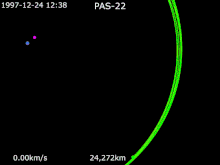
The maneuvers burned through a lot of the onboard propellant, which cut the operable lifespan of the satellite in half, but that was much better than losing the satellite entirely.
This is a good illustration of another value in bi-elliptic transfers: inclination corrections. It is MUCH more inexpensive to change inclination at apogee than at perigee, and the higher the apogee the better. Most GTO launches today actually place the comsat's apogee well above geostationary altitudes so that the satellite will expend less onboard propellant to correct inclination and raise perigee.
-
I’m guessing one of two possibilities on the first stage rapid unscheduled disassembly. The obvious is that hot staging is a nasty affair and the upper bulkhead simply couldn’t take the heat. That would make sense. Another possibility is that the slosh during that very energetic booster flip was significantly more chaotic than expected and they had engine starvation problems. The graphic depicting which engines were firing may have supported this, as most of the engines on one side lit successfully, while the ones on the other side did not.
The apparent loss of the second stage is much more mysterious and doesn’t seem to have any immediate explanation. I think someone up thread mentioned a possible, autogenous pressurization failure, and that seems like a reasonable possibility, especially if damage sustained during hot staging punctured the tanks somewhere and caused a slow leak that auto press simply couldn’t overcome at the end of the burn when the tanks were mostly empty. Regardless, good job and congrats to everyone.
-
1 minute ago, Minmus Taster said:
Of course it's only on X, now I need to watch a low quality video of someone streaming it : /
You should be able to watch it off-X here.
-
57 minutes ago, Ultimate Steve said:
Conduction to the rear of the ship over the surface area of the very thin tank walls (let's be extremely generous and assume 5 centimeters thick taking into account internal radiation bypassing the nose shield and stringers and such) (surface area ~1.4 square meters) (90K CH4 tank immediately behind 270K nose cone) will be calculated also. The section between the tank and the nose is, what, 10 meters long on an unmodified non depot starship? The depot one may be different but the extra length helps us here. Heat getting to the fuel is now 369W, and as we found earlier, Starship radiates about 600W by itself. Even assuming it doesn't, we have reduced the boiloff, in theory, to 114kg/day. Even if I'm off by a factor of 10, just by pointing Starship in the right direction, with not that much modification, that's like a ton of fuel per day, which is well manageable.
Now you've got me wondering whether the emissivity of the heat shield tiles comes into play, assuming we are using a reusable tanker Starship. Obviously they are not good at conducting heat, which makes them less useful...but they have VERY good emissivity, so that's something to consider.
Also wondering if pointing Starship engines-first at the sun makes any difference.
I could see a stretched depot Starship with a disposable fairing that covers a deployable heat shade, too; that's a possibility.
Methane is not a super great coolant by any means but it's better than some things. They could go in a direction similar to ACES and use gaseous boiloff from both tanks to operate a small internal combustion engine that pumps methane gas into a radiator, compresses it, and then recycles it back in to make a Carnot heat engine. It's been a while since I took thermodynamics so I am not sure about the physics of using a larger mass of coolant to make up for poorer coolant properties and lower power.
19 minutes ago, Royalswissarmyknife said:The hype is at the max!
Here we go!
-
4 minutes ago, darthgently said:
Is the boil-off during ascent from atmospheric heating significantly faster than once in orbit? What percentage of fuel as payload makes it to orbit? High teens still seems really high though. Are other dv requirements not being accounted for beyond the core mission?
There shouldn't be significant boil-off due to atmospheric heating; we are talking about huge volumes of propellant in a reasonably well-insulated tube with low surface-area-to-volume ratios. And atmospheric heating during ascent is really not terribly significant...dynamic pressure peaks early and even that doesn't come with significant heating.
Maybe they are talking about the amount of propellant that will have to reach orbit to enable a full-loop mission with refueling in elliptical orbit, or something.
Or maybe boil off in space is much worse than previously thought. That's the unsettling possibility.
-
No current market for bulk raw materials in space, really.



SpaceX Discussion Thread
in Science & Spaceflight
Posted
To be clear, you would definitely need continuous acceleration for settling regardless of whether you used a pump. The weight of a pump that can move tens of tonnes of liquid quickly is non-negligible, and neither is the weight of a sufficient power source.
In contrast, if you're transferring by constant ullage acceleration then you're only losing gas -- gas that would have to be displaced anyway as the destination tank is filled.